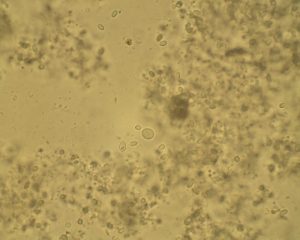The causative agent of this infection is the organism Malpighamoeba mellificae. There are no outward symptoms of the infection and a positive diagnosis of M. mellificae can only be made by microscopic examination to identify the amoebic cysts. It has been suggested that infections of M. mellificae are associated with spring dwindling, dysentery and shortening the lifespan of infected bees. However, there is no evidence to support this and the effect of an infection is not clearly known. M. mellificae infections are very often found in association with nosemosis and it is likely that a dual infection will be more damaging to the health of the honey bee.

Treatment and Control
Hygiene and good management is the key to controlling spread of the organism, as with Nosema and other infections. There are currently no approved proprietary products registered for the control of M. mellificae in the UK.
Adapted from BeeBase, National Bee Unit, Animal Health and Plant Agency (APHA) under the terms of the Open Government Licence (OGL). Crown Copyright.